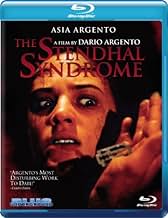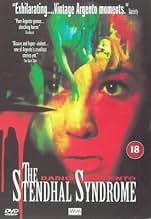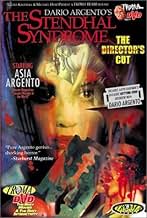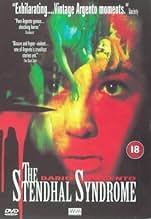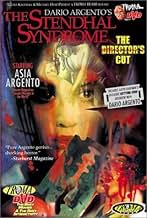AVALIAÇÃO DA IMDb
6,0/10
9,6 mil
SUA AVALIAÇÃO
Uma jovem mulher policial vai lentamente enlouquecendo enquanto segue um esquivo estuprador e assassino em série pela Itália.Uma jovem mulher policial vai lentamente enlouquecendo enquanto segue um esquivo estuprador e assassino em série pela Itália.Uma jovem mulher policial vai lentamente enlouquecendo enquanto segue um esquivo estuprador e assassino em série pela Itália.
- Direção
- Roteiristas
- Artistas
- Prêmios
- 1 vitória e 6 indicações no total
Avaliações em destaque
Dario Argento is one of my all-time favorite directors, and probably THE living director I admire the most. The 1990s were a weak decade for Horror in general, and also Argento's weakest. Argento is a cinematic genius, however, and while 90s achievements get nowhere near the brilliance of his masterpieces from the 70s and 80s, films like "Trauma" (1993) or this "Stendhal Syndrome" are nonetheless more than decent Thrillers that outshine the majority of 90s Horror outings.
"La Sindrome Di Stendhal" aka "The Stendhal Syndrome", which was made in-between "Trauma" and the disappointing "Il Fantasma Dell'Opera" (1998), is certainly one of his lesser films, but definitely a more than decent, very suspenseful, atmospheric and often quite weird psychological Horror effort that his fans cannot afford to miss. I like it about equally as I do "Trauma", with a slight preference for "The Stendhal Syndrome" due to the brilliant score by Ennio Morricone. What I found a bit strange is that the film is often labeled as a Giallo, when it is not really. There are no stylishly bloody murders from the killer's perspective, and really what makes the term "Giallo" quite out of place is the fact that the killer's identity is not really a mystery. The suspense is there, however, and most true Horror fans will agree that Argento is the absolute master of suspense. While the film is not quite as exceptionally gory as many other Argento flicks, it is definitely violent, especially the several rape-scenes (one of them taking place quite in the beginning) are more than a bit brutal.
Argento reportedly first wanted to get Bridget Fonda and Jenifer Jason Leigh for the leading role in the film, but his beautiful daughter Asia Argento is, as far as I am considered, the perfect cast for the role. She may look a little too young for an experienced female homicide detective, but she fits the character of her role perfectly, and, as far as I am considered, that is most important. Asia plays detective Anna Manni, a Rome investigator specialized on sex crimes, who is trying to track down a serial rapist and murderer... I do not want to give any more of the plot away. The rest of the performances are also quite good, especially the German actor Thomas Kretschmann delivers a good performance, but Asia Argento sure is the highlight. The film is quite different to Argento's other films, but certainly not bad. None other than the great Ennio Morricone delivers a brilliant and immensely eerie score that intensifies the creepy atmosphere, and, as it is always the case with Argento's films, the film is visually stunning and highly suspenseful.
Dario Argento's masterpieces are his films from the 70s and 80s, and he returned to old greatness in 2001, with the ultra-violent and greatly old-fashioned Neo-Giallo "Non Ho Sonno" (aka. "Sleepless"), which was made in brilliant Argento-tradition. His 90s outings are certainly a bit inferior to the rest of his brilliant repertoire, but they are nonetheless way above average. While it is one of lesser films, "The Stendhal Sydrome" is nevertheless a suspenseful, atmospheric and highly recommendable film with some downright ingenious elements that Horror lovers should definitely not miss. Highly recommended!
"La Sindrome Di Stendhal" aka "The Stendhal Syndrome", which was made in-between "Trauma" and the disappointing "Il Fantasma Dell'Opera" (1998), is certainly one of his lesser films, but definitely a more than decent, very suspenseful, atmospheric and often quite weird psychological Horror effort that his fans cannot afford to miss. I like it about equally as I do "Trauma", with a slight preference for "The Stendhal Syndrome" due to the brilliant score by Ennio Morricone. What I found a bit strange is that the film is often labeled as a Giallo, when it is not really. There are no stylishly bloody murders from the killer's perspective, and really what makes the term "Giallo" quite out of place is the fact that the killer's identity is not really a mystery. The suspense is there, however, and most true Horror fans will agree that Argento is the absolute master of suspense. While the film is not quite as exceptionally gory as many other Argento flicks, it is definitely violent, especially the several rape-scenes (one of them taking place quite in the beginning) are more than a bit brutal.
Argento reportedly first wanted to get Bridget Fonda and Jenifer Jason Leigh for the leading role in the film, but his beautiful daughter Asia Argento is, as far as I am considered, the perfect cast for the role. She may look a little too young for an experienced female homicide detective, but she fits the character of her role perfectly, and, as far as I am considered, that is most important. Asia plays detective Anna Manni, a Rome investigator specialized on sex crimes, who is trying to track down a serial rapist and murderer... I do not want to give any more of the plot away. The rest of the performances are also quite good, especially the German actor Thomas Kretschmann delivers a good performance, but Asia Argento sure is the highlight. The film is quite different to Argento's other films, but certainly not bad. None other than the great Ennio Morricone delivers a brilliant and immensely eerie score that intensifies the creepy atmosphere, and, as it is always the case with Argento's films, the film is visually stunning and highly suspenseful.
Dario Argento's masterpieces are his films from the 70s and 80s, and he returned to old greatness in 2001, with the ultra-violent and greatly old-fashioned Neo-Giallo "Non Ho Sonno" (aka. "Sleepless"), which was made in brilliant Argento-tradition. His 90s outings are certainly a bit inferior to the rest of his brilliant repertoire, but they are nonetheless way above average. While it is one of lesser films, "The Stendhal Sydrome" is nevertheless a suspenseful, atmospheric and highly recommendable film with some downright ingenious elements that Horror lovers should definitely not miss. Highly recommended!
One of the key things in setting up a horror movie for a director has to be mood: if you get your mood right, then you've taken your first step into a larger, more controlled mis-en-scene. Dario Argento is such a bad-ass with mood that one wonders if he comes on to his sets like one of those gunslingers so ready and able that you can feel him draw his eye on a scene in his own way before anyone else can do it so. The mood he sets up, and keeps going on in a disturbing manner, for the Stendhal Syndrome involves a character who we see in the opening scenes walking along in a busy street, go into a museum and just staring at the paintings. But something else is going on: she (Asia Argento) keeps feeling dizzy, looking around mesmerized, not in a good way. She suddenly stares at a painting, feverishly, and sees herself going into the painting itself, in the deep blue ocean of a landscape - and then she awakes, not sure where she was before in the museum. A man comes to help her outside since she left her purse behind, but is this man who he says he...
OK, Argento can take it from here. This is a story that may, in fact, be more disturbing than his films from the 1970s. This doesn't mean it's quite as unforgettable or masterful - a few little things and a couple of potential big things keep it from greatness - but it's never less than interesting as part of Argento canon. One of the things to notice is that, unlike in the past, Argento isn't interested this time in fetishizing the aspect of the "mystery killer" throughout the film. On the contrary, the killer is right out in the open, a truly, brilliantly insane rapist-killer played by Thomas Kreutschman, who helps Asia outside the museum... but then returns when she's on the phone with him (one of those awesome "JUMP" scares when he sort of magically appears in the room), and rapes and beats her. Argento likes this actor in the role, and he's so effective in that we hate him so much and can't wait to see his just desserts gotten.
The other interesting thing is the treatment of the protagonist in this very (psychologically-speaking) twisted Giallo - in part due to the casting. Some may be able to get past the fact that this is Argento's daughter in the lead (originally, to give the benefit of the doubt, Bridget Fonda was cast and then backed out), and he puts her through some grueling things; aside from the obvious (scenes of rape and nudity and some brutal violence), there's the plunging deep into the scarring of a woman who already has a truly surreal disease not unlike an obscure comic-book hero. These are some of the freakiest scenes I've ever seen in any movie, if one can apply 'freaky' here which it should be: seeing her fall into these paintings, the faces of the sculptures, make it about the horror of the abstract intruding in on life, and these are quite creative. The other thing is how far Asia Argento goes into her sickness after the halfway point, when we think things should be getting better following a horrific encounter and the aftermath.
It's a performance that Asia is game for, and she gives it her all, even when things turn into those ludicrous beats one can see from time to time in Dario's movies. One short scene I loved was when Anna is putting on her make-up, slowly, taking her time, putting on her blonde wig (a Hitchcock touch?) while the buzzer is going off frantically and the Ennio Morricone score- as usual a variation on a great theme- plays on. One of the things that ends up making it tolerable of what the father is putting his daughter through here is that it's such a ballsy movie in typical Giallo clothing, reevaluating true evil vs true psychosis. It's only exploitive in certain little things that stick out, such as the silly CGI shot of the pill going down the throat (unnecessary) or the bullet going through the head or with the slow-motion reflection of the killer on the sheen of the bullet. And there are story things that seem a little too simple to bare on first thought, like how quickly Anna bags a guy whom she genuinely is attracted to and doesn't tell him a thing until a certain day when... well, you'll get the idea.
Sure, we've seen the detective-plot stuff, and sure the acting isn't all around very good all of the time save for its two main leads. But when its director gets going with something, it's still invigorating and cringe-worthy a lot of the time. My face when watching this film was a series of slack-jawed pauses and upturned eyebrows. It's gory and flamboyantly directed and it's a hell of a mind-f***, but it works, ultimately, and even underrated.
OK, Argento can take it from here. This is a story that may, in fact, be more disturbing than his films from the 1970s. This doesn't mean it's quite as unforgettable or masterful - a few little things and a couple of potential big things keep it from greatness - but it's never less than interesting as part of Argento canon. One of the things to notice is that, unlike in the past, Argento isn't interested this time in fetishizing the aspect of the "mystery killer" throughout the film. On the contrary, the killer is right out in the open, a truly, brilliantly insane rapist-killer played by Thomas Kreutschman, who helps Asia outside the museum... but then returns when she's on the phone with him (one of those awesome "JUMP" scares when he sort of magically appears in the room), and rapes and beats her. Argento likes this actor in the role, and he's so effective in that we hate him so much and can't wait to see his just desserts gotten.
The other interesting thing is the treatment of the protagonist in this very (psychologically-speaking) twisted Giallo - in part due to the casting. Some may be able to get past the fact that this is Argento's daughter in the lead (originally, to give the benefit of the doubt, Bridget Fonda was cast and then backed out), and he puts her through some grueling things; aside from the obvious (scenes of rape and nudity and some brutal violence), there's the plunging deep into the scarring of a woman who already has a truly surreal disease not unlike an obscure comic-book hero. These are some of the freakiest scenes I've ever seen in any movie, if one can apply 'freaky' here which it should be: seeing her fall into these paintings, the faces of the sculptures, make it about the horror of the abstract intruding in on life, and these are quite creative. The other thing is how far Asia Argento goes into her sickness after the halfway point, when we think things should be getting better following a horrific encounter and the aftermath.
It's a performance that Asia is game for, and she gives it her all, even when things turn into those ludicrous beats one can see from time to time in Dario's movies. One short scene I loved was when Anna is putting on her make-up, slowly, taking her time, putting on her blonde wig (a Hitchcock touch?) while the buzzer is going off frantically and the Ennio Morricone score- as usual a variation on a great theme- plays on. One of the things that ends up making it tolerable of what the father is putting his daughter through here is that it's such a ballsy movie in typical Giallo clothing, reevaluating true evil vs true psychosis. It's only exploitive in certain little things that stick out, such as the silly CGI shot of the pill going down the throat (unnecessary) or the bullet going through the head or with the slow-motion reflection of the killer on the sheen of the bullet. And there are story things that seem a little too simple to bare on first thought, like how quickly Anna bags a guy whom she genuinely is attracted to and doesn't tell him a thing until a certain day when... well, you'll get the idea.
Sure, we've seen the detective-plot stuff, and sure the acting isn't all around very good all of the time save for its two main leads. But when its director gets going with something, it's still invigorating and cringe-worthy a lot of the time. My face when watching this film was a series of slack-jawed pauses and upturned eyebrows. It's gory and flamboyantly directed and it's a hell of a mind-f***, but it works, ultimately, and even underrated.
The Stendhal Syndrome is said to be a disorder where, upon viewing works of art, a person suffers from chills, anxiety attacks, and hallucinations where they believe they're actually in the paintings themselves. Don't ask me how real or common this disorder is since I'm not a doctor, but it sure makes for an interesting case study in Dario Argento's The Stendhal Syndrome.
Anna Manni (Asia Argento) is an Italian police detective who goes to an art museum due to an phone tip from a woman claiming that she knows a serial rapist and murderer will be there. Once there, Anna suffers from an attack of Stendhal and ends up getting knocked out. When she comes to, a man is there and he follows her back to her room, rapes her, and kidnaps her, forcing her to watch him murder another victim. She flees from the scene, but the worst is yet to come.
It's hard to talk about this film without spoiling everything, but let's just say that the character of Anna goes through several transitions throughout the film. The 1st act of the film is pretty gripping and the 2nd act isn't terrible either, but by the 3rd act, you get the feeling like they don't know how to wrap this up so they're just stalling and making up stuff to distract us from the fact that the movie hasn't cleared for landing yet. By the end, you'll definitely be left scratching your head and wishing they'd have just ended it a half hour sooner.
Asia Argento isn't ideally suited for the role either and only seems to really come to life during the 2nd act where she adopts a touch, butch persona. She seems uncomfortable in the 1st and 3rd acts. There are also some questionable CGI effects throughout that take you out of the movie and it's not as stylish as many of Dario Argento's other works.
Anna Manni (Asia Argento) is an Italian police detective who goes to an art museum due to an phone tip from a woman claiming that she knows a serial rapist and murderer will be there. Once there, Anna suffers from an attack of Stendhal and ends up getting knocked out. When she comes to, a man is there and he follows her back to her room, rapes her, and kidnaps her, forcing her to watch him murder another victim. She flees from the scene, but the worst is yet to come.
It's hard to talk about this film without spoiling everything, but let's just say that the character of Anna goes through several transitions throughout the film. The 1st act of the film is pretty gripping and the 2nd act isn't terrible either, but by the 3rd act, you get the feeling like they don't know how to wrap this up so they're just stalling and making up stuff to distract us from the fact that the movie hasn't cleared for landing yet. By the end, you'll definitely be left scratching your head and wishing they'd have just ended it a half hour sooner.
Asia Argento isn't ideally suited for the role either and only seems to really come to life during the 2nd act where she adopts a touch, butch persona. She seems uncomfortable in the 1st and 3rd acts. There are also some questionable CGI effects throughout that take you out of the movie and it's not as stylish as many of Dario Argento's other works.
I don't really understand why so many Argento fans dislike this film, I think it's one of his best works. It's not always easy to watch, it has some very nasty violence, even for an Argento film, I wouldn't recommend the film to sensitive persons; but it's not for exploitational purposes. Argento does a good job of juggling real-life horrors with a dreamy, hallucinatory atmosphere, and pulls off some typically Argento-esque setpieces, such as the one in which a bullet is followed through a woman's mouth with the aid of CGI. The great Ennio Morricone delivers possibly his best score for a horror film, the haunting main theme with his trademark wordless female vocals stayed with me long after the film was over. Frequent Fellini cameraman Giuseppe Rotunno does an excellent job on the film too.
The Stendhal Syndrome isn't for everyone, but it's worth a viewing for fans of European horror and psychological thrillers in general.
The Stendhal Syndrome isn't for everyone, but it's worth a viewing for fans of European horror and psychological thrillers in general.
Regarded as one of Argento's lesser works, I find this one much more plausible than any of his early films. Let's face it, Argento doesn't care much about plot or even acting. His films are probably the frustrating I've ever seen: There are things I love, and things I hate about them. I grew up watching much of his films mutilated by Italian Television. I was a kid back then, and strangely enough his films never scared me when they were supposed to. They were really over the top. But I loved the colours, the pictures and once in a while I found myself humming Claudio Simonetti's electronic scores.
Now with this film Argento has Morricone, who is definitely a master and he does a great job here. Anna's character is really intriguing. Some people dismiss Asia's acting style, but I think it goes very well with her father's aesthetics. You wont find the crazy colours here. Everything is more restrained. The opening for example scene is great. But the film looses interest towards the end. Still I think is one of Argento's most solid pieces. The idea is truly interesting and Anna's relationship with the killer is fascinating. The hallucinations scenes of Anna going into the paintings are masterfully done.
After the huge disappointment of Il Cartaio, I hope he truly returns to form, and start doing what he's good at: Going crazy with film. La Sindrome Di Stendhal is a pretty good step.
Now with this film Argento has Morricone, who is definitely a master and he does a great job here. Anna's character is really intriguing. Some people dismiss Asia's acting style, but I think it goes very well with her father's aesthetics. You wont find the crazy colours here. Everything is more restrained. The opening for example scene is great. But the film looses interest towards the end. Still I think is one of Argento's most solid pieces. The idea is truly interesting and Anna's relationship with the killer is fascinating. The hallucinations scenes of Anna going into the paintings are masterfully done.
After the huge disappointment of Il Cartaio, I hope he truly returns to form, and start doing what he's good at: Going crazy with film. La Sindrome Di Stendhal is a pretty good step.
Você sabia?
- CuriosidadesThe opening scene was shot inside the famous Uffizi Gallery in Florence. As of 2014, Dario Argento is the only director who's ever received permission to film inside the museum.
- Erros de gravaçãoThough featuring prominently during the film's opening sequence set at the Uffizi in Florecne, Peter Bruegel's 'Landscape with the Fall of Icarus' is actually housed at the Royal Museum of Fine Arts of Belgium in Brussels.
- Citações
Insp. Manetti: You're young. I can trust you.
- Versões alternativasUS DVD release by Troma release is the complete version of the English language edition, but, like all English releases, is still missing around 2 minutes of material exclusive to the Italian print.
- ConexõesFeatured in Il mondo di Dario Argento 3: Il museo degli orrori di Dario Argento (1997)
Principais escolhas
Faça login para avaliar e ver a lista de recomendações personalizadas
Detalhes
Bilheteria
- Orçamento
- US$ 3.800.000 (estimativa)
- Tempo de duração2 horas
- Cor
- Mixagem de som
- Proporção
- 1.85 : 1
Contribua para esta página
Sugerir uma alteração ou adicionar conteúdo ausente

Principal brecha
By what name was Síndrome Mortal (1996) officially released in India in English?
Responda


